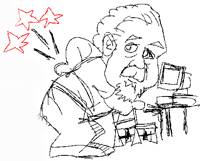More Donut Crumbs
Loosen Up and Have More Fun
One thing that seems very common in artists who learn their animation skills using computer animation applications is their almost impatient urge to rush to a finished product. Perhaps it is just the desire to be gratified quicker, perhaps it is the lack of patients of youth, and perhaps it is the way many software applications are implemented. Youthful enthusiasm and the desire to be gratified quickly are eventually tempered by experience and confidence. The structural problems presented by software just must be recognized and accounted for in the workflow. Specifically, I am referring to the aspect of many animation applications which discourage rough sketching. In most applications, like Flash for example, any rough sketching or layout drawing work must be deleted and discarded if produced, otherwise it would be incorporated in the rendered output. This is unfortunate as it tends to prompt the sense that these steps are wasted and therefore should be avoided. Nothing could be farther from the truth.
Not only are rough drawings and layouts important steps in producing animated content, they are essential to producing loose and dynamic movement. Perhaps it seems that animation leaps to a finish state automatically but it doesn’t. And most skilled animators begin with highly fluid gestures as a means of visualizing their poses and action. Gesture is mostly about capturing the essence or feeling of the action. One of the real problems in the creation of animated content is maintaining the “energy” that usually is captured in the rough gesture stage all the way through the “clean up” stages. One reason we like Toon Boom Studio as production software is the fact that it doesn’t require you to discard your rough gesture work. You can just check or uncheck an “include /exclude” check box to add or remove any scene or element from your rendered movie.

Being Spontaneously Organized
Most creative people would like to view their efforts as spontaneous expressions of their passion and vision. Yet for all but the simplest of creations there is less that is spontaneous and more that is planned and executed through many phases of work. There are two important and often dreaded concepts that every artist has to embrace sooner or later. They are the concepts of collaboration and project management.
I have written before about collaborations. (You can read about them HERE.) Collaborations don’t have to be viewed as limitations, in fact from my own personal experience, they can be energizing and liberating. I’ll have more to say on that in a future article.
But my next few articles will be oriented toward the other dreaded concept, projects and project management. I am mainly focused here in a discussion of creating animated content, commercials and cartoons specifically. You might be asking “what does project management have to do with that?” If so, please stick around because this is going to be enlightening.
The creation and production of any animated content is most definitely a project. And even if you are a one person production unit, you still will have to organize and manage your projects if you want to have a chance to be successful. In fact because you have chosen animation as your medium of expression you had better embrace planning and organization as your friends or become prepared to suffer a horrible fate in the land of, dare I say it, “Cartoonist’s Hell”. You have surely heard the old expression “If you fail to plan, you plan to fail”. Well that must have been coined by someone making animated cartoons because it is so totally true.
I guess I also should point you to a previous article on the value of using story boards for planning. (You can read about them HERE.)
One of the biggest hurtles to overcome in producing an animated cartoon is time. But probably not time as you might expect it, as most people think in terms of time as in “how much time do we have before our deadline?” Certainly deadlines are important parts of project planning and execution. But the time hurtle I’m referring to here is different. It is the very long beginning to end time required to create animated content. Why is it a significant obstacle? Because the longer something takes to complete the more it usually leads to serious project fatigue.

Actually what I am describing is a very common feeling that occurs during extended projects particularly creative projects. We all start out fresh and excited and the concepts are new and interesting. Then over time the newness wears off and it becomes very familiar, then some more time passes and what was a once fresh and new starts to appear really old and tired and we seriously feel that we could and should be doing something fresh and new. It is called being too close to your work. We all go thru this stage in our long projects. For many people this is a great excuse to quit and the project never gets finished. Some people put the project away and let some time pass and then return to it later when they can have a fresh outlook. You just have a case of long project fatigue which is totally natural, but can be dangerous. Surprisingly although this is a common occurrence in long projects very few people plan for it or plan on how to deal with it. They just experience it and very often project fatigue ruins an otherwise good project. Be sure to check back for more on projects and project management in a future article.
One thing that seems very common in artists who learn their animation skills using computer animation applications is their almost impatient urge to rush to a finished product. Perhaps it is just the desire to be gratified quicker, perhaps it is the lack of patients of youth, and perhaps it is the way many software applications are implemented. Youthful enthusiasm and the desire to be gratified quickly are eventually tempered by experience and confidence. The structural problems presented by software just must be recognized and accounted for in the workflow. Specifically, I am referring to the aspect of many animation applications which discourage rough sketching. In most applications, like Flash for example, any rough sketching or layout drawing work must be deleted and discarded if produced, otherwise it would be incorporated in the rendered output. This is unfortunate as it tends to prompt the sense that these steps are wasted and therefore should be avoided. Nothing could be farther from the truth.
Not only are rough drawings and layouts important steps in producing animated content, they are essential to producing loose and dynamic movement. Perhaps it seems that animation leaps to a finish state automatically but it doesn’t. And most skilled animators begin with highly fluid gestures as a means of visualizing their poses and action. Gesture is mostly about capturing the essence or feeling of the action. One of the real problems in the creation of animated content is maintaining the “energy” that usually is captured in the rough gesture stage all the way through the “clean up” stages. One reason we like Toon Boom Studio as production software is the fact that it doesn’t require you to discard your rough gesture work. You can just check or uncheck an “include /exclude” check box to add or remove any scene or element from your rendered movie.

Being Spontaneously Organized
Most creative people would like to view their efforts as spontaneous expressions of their passion and vision. Yet for all but the simplest of creations there is less that is spontaneous and more that is planned and executed through many phases of work. There are two important and often dreaded concepts that every artist has to embrace sooner or later. They are the concepts of collaboration and project management.
I have written before about collaborations. (You can read about them HERE.) Collaborations don’t have to be viewed as limitations, in fact from my own personal experience, they can be energizing and liberating. I’ll have more to say on that in a future article.
But my next few articles will be oriented toward the other dreaded concept, projects and project management. I am mainly focused here in a discussion of creating animated content, commercials and cartoons specifically. You might be asking “what does project management have to do with that?” If so, please stick around because this is going to be enlightening.
The creation and production of any animated content is most definitely a project. And even if you are a one person production unit, you still will have to organize and manage your projects if you want to have a chance to be successful. In fact because you have chosen animation as your medium of expression you had better embrace planning and organization as your friends or become prepared to suffer a horrible fate in the land of, dare I say it, “Cartoonist’s Hell”. You have surely heard the old expression “If you fail to plan, you plan to fail”. Well that must have been coined by someone making animated cartoons because it is so totally true.
I guess I also should point you to a previous article on the value of using story boards for planning. (You can read about them HERE.)
One of the biggest hurtles to overcome in producing an animated cartoon is time. But probably not time as you might expect it, as most people think in terms of time as in “how much time do we have before our deadline?” Certainly deadlines are important parts of project planning and execution. But the time hurtle I’m referring to here is different. It is the very long beginning to end time required to create animated content. Why is it a significant obstacle? Because the longer something takes to complete the more it usually leads to serious project fatigue.

Actually what I am describing is a very common feeling that occurs during extended projects particularly creative projects. We all start out fresh and excited and the concepts are new and interesting. Then over time the newness wears off and it becomes very familiar, then some more time passes and what was a once fresh and new starts to appear really old and tired and we seriously feel that we could and should be doing something fresh and new. It is called being too close to your work. We all go thru this stage in our long projects. For many people this is a great excuse to quit and the project never gets finished. Some people put the project away and let some time pass and then return to it later when they can have a fresh outlook. You just have a case of long project fatigue which is totally natural, but can be dangerous. Surprisingly although this is a common occurrence in long projects very few people plan for it or plan on how to deal with it. They just experience it and very often project fatigue ruins an otherwise good project. Be sure to check back for more on projects and project management in a future article.

0 Comments:
Post a Comment
<< Home